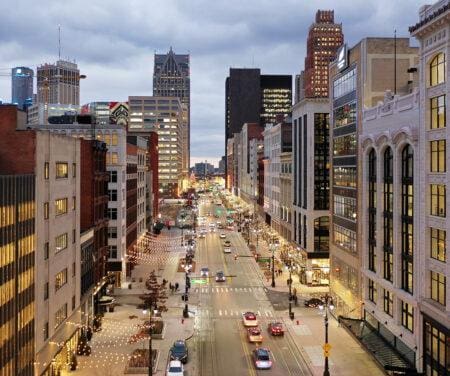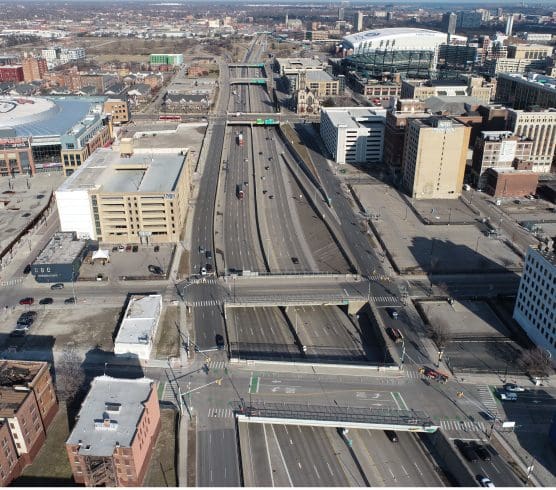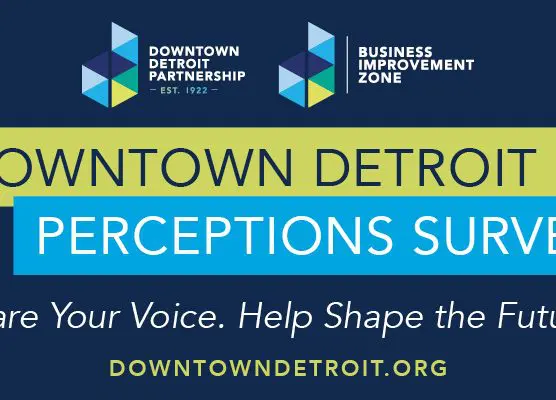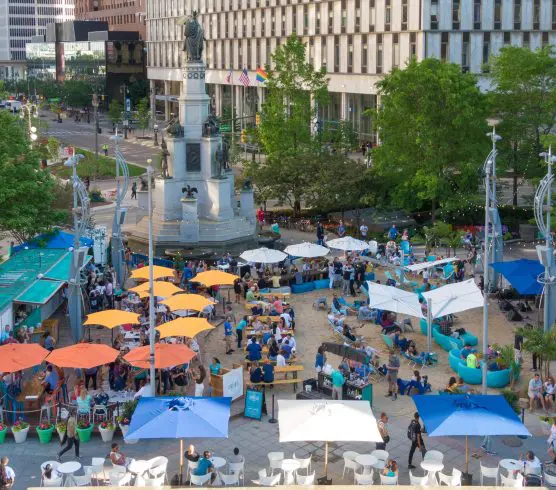By Eric B. Larson
You may have noticed that I close each CEO Update with “See you in the parks.” This statement has a deeper purpose and meaning than simply a closing salutation.
THE INVESTMENT
The Michigan Economic Development Corporation (MEDC) is currently reviewing applications to consider how best to spend federal dollars received as part of the American Rescue Plan Act. The MEDC plans to give the City of Detroit a portion of the $100 million assigned to the State of Michigan. A coalition of public- and private-sector partners, including the Downtown Detroit Partnership, is advocating for a portion of the federal funds to be allotted to what we believe will be the next critical phase of Downtown Detroit’s progress as a dynamic, evolving and accessible American city.
THE NEED
This next phase recognizes that COVID-19 created a shift in focus from “office-based work” to “working,” “living” and “playing” with flexibility. A shift that emphasizes how to view our public spaces as workspaces, playgrounds, dining rooms, theaters and centers for community.
In fact, this coalition has come together with a unity of purpose and strategy consistent with our collective organizations’ history.
WHO
The coalition comprises the Downtown Detroit Partnership, Greektown Neighborhood Partnership, Paradise Valley Conservancy, Bedrock Detroit and Karp + Associates — all representing major stakeholders in Downtown Detroit.
The intent of the MEDC fund application is what we believe will put Downtown Detroit at the forefront of best practices by understanding the dynamic shift presented by COVID-19, the severity of its impact and its opportunities for the future.
THE TRANSFORMATION
Pre COVID, Downtown Detroit was an office-dominated district, with over 70,000 daily office workers and only 6,200 residents. COVID-19 led to a sharp decline in visitors but an even more stark and enduring drop in the daily office population. Even today, with workers’ return to offices around the region, the downtown office worker population remains down 60 percent from pre-COVID levels. This represents a fundamental shock to the Downtown economy and its small business community. It also has significant fiscal implications for the City of Detroit, which estimates $50 million in annual tax revenue loss due to remote work.
We have seen a significant increase in the volume of weekend visitors and Detroit residents discovering Downtown over the past two years but still not enough to offset the weekday loss in volume.
After a decade of positive transformation that changed the perception of Detroit around the world, Downtown Detroit is now at an inflection point. Given the gravity of this moment, we must unite around an organized recovery strategy.
Simply put, to be successful and sustainable in the future, Downtown Detroit must transition from a place dominated by “work” to one increasingly focused on growing the “live” and “play” dimensions of the economy. With the reduction of traditional office workers, there is no substitute or strategy other than creating new destinations that provide compelling reasons to come downtown, spend Downtown, and live Downtown. Only by doing this can we, in a sustainable way, generate new demand for small businesses, attract new businesses large and small, and generate new tax revenue for the City. This enhanced focus will ultimately impel more investment in the Downtown and position the City to serve the workplace better as it evolves. While we can’t predict the future, we will do what we can to prepare for it recognizing the economic and social impact of workers and the companies that employ them. This has been and always will be at the core of DDP’s mission and programs.
THE FUTURE IS NOW
It is important to emphasize that the coalition’s projects are not only progressive but also prepared to move forward immediately. The projects are shovel-ready. They have been
researched and vetted, and the public — and its private-sector partners — will reap the rewards sooner, allowing both the grantees and awardees to build on their nearly immediate successes and past investments (or commitments).
THE PROJECTS
The application’s three projects are strategically and geographically aligned, concentrated along the Woodward Avenue and Randolph Street corridors for maximum impact and strengthening connections. Specifically:
• The DDP’s three projects will advance the “live-play” strategy by enhancing the iconic public spaces along Downtown’s Woodward Avenue spine. No public spaces are more important in driving visitors—and the visitor experience—than Campus Martius Park, Grand Circus Park and Capitol Park. They are the “welcome mat” Downtown Detroit puts out for the world. At the same time, these spaces represent the outdoor “living room” for the businesses and residents around them. The improvements and new amenities made possible through this application will give more visitors a better experience while further enhancing Downtown’s value proposition as a place to play, live, and work.
• The Karp + Associates’ 1133 Griswold project will strengthen the Capitol Park neighborhood by rehabilitating a vacant and blighted building on the southern end of the neighborhood into a mixed-use residential property, further bringing new residents and customers to the community.
• The Paradise Valley Conservancy’s two placemaking projects, the GNP’s Randolph Plaza project and Bedrock’s rehabilitation of the Harvard Square building, will advance the shared strategy by catalyzing the transformation of the Randolph Corridor into a thriving “live-play” zone rivaling the most dynamic American cities. The strategic Randolph Corridor—which connects the Central Business District, Greektown, Paradise Valley and the Stadium District—is the part of Downtown with the most blight and vacancy but also the greatest potential to become a world-class “live-play” zone. This project speaks directly to our recognizing the past as we look to the future. Ignoring the restoration of culturally significant neighborhoods in and around the Downtown is a missed opportunity to acknowledge – even in a small way – the sins of past planning.
Clearly, there is much more that we can and will do in partnership with the Mayor’s team, and there is much the city needs to do in the areas of education and safety. We should not view these as isolated agendas but as part of one agenda to keep Detroit — as Time Magazine recently proclaimed – “one of the world’s greatest destinations.”
Watch the website for more from the DDP on the social and economic impact of Parks and Public Spaces and other key topics.



